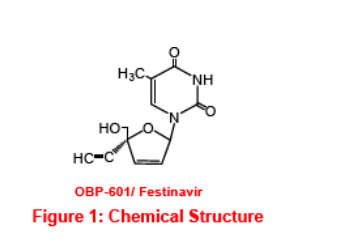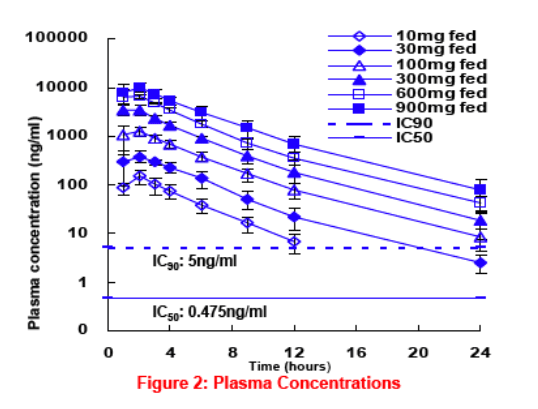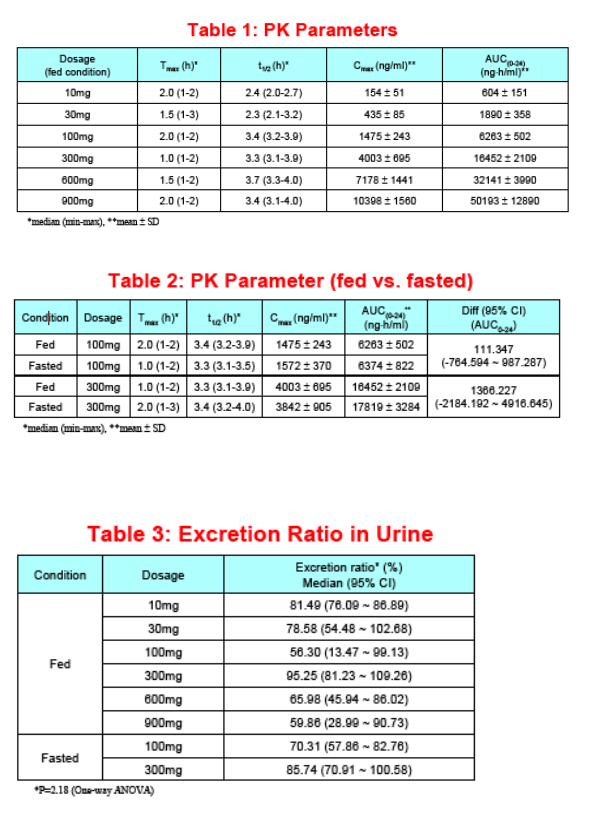 |
 |
 |
| |
A Single-dose Escalation Study to Evaluate the Safety, Tolerability, and Pharmacokinetics of OBP-601, a Novel NRTI, in Healthy Subjects
|
| |
| |
Reported by Jules Levin
CROI 2009 Feb 8-12 Montreal
E Paintsil1, Takuma Mastuda*2, J Ross3, J Schofield4, Y-C Cheng1, and Y Urata2
1Yale Univ Sch of Med, New Haven, CT, US; 2Oncolys BioPharma Inc, Tokyo, Japan; 3IBERICA Clinical Res Ctr, Eatontown, NJ, US; and 4Tandem Labs, West Trenton, NJ, US
AUTHOR CONCLUSIONS
--Festinavir was safe and well tolerated
--Festinavir plasma pharmacokinetics demonstrated dose-proportional relationship across the dose range studied in healthy men
--At doses ranging from 100 to 900 mg given once a day, the plasma concentration of Festinavir remained above the IC90 through the dosing period (24 h); QD dosing is anticipated
--Phase 1b to further evaluate safety, tolerability, PK, and antiviral activity of Festinavir is ongoing
OBP-601 (Festinavir@) is a novel NRTI.
Background: OBP-601 is a novel NRTI (derivative of stavudine, d4T) with potent in vitro anti-HIV activity against several wild type HIV-1 subtypes and multidrug resistant (MDR) clinical isolates. Strains with M184V mutation showed 3- to 10-fold decrease in susceptibility. It is less inhibitory to mitochondrial DNA synthesis in cell culture and its anti-HIV activity persists longer than other thymidine analogs after removal from cell culture.
Methods: A single-blind, placebo-controlled single oral dose escalation study was conducted in 64 healthy male volunteers. There were 8 cohorts of 8 subjects (6 active / 2 placebos); 6 cohorts received doses of 10, 30, 100, 300, 600, or 900 mg in the fed state, and 2 cohorts received 100 or 300 mg in the fasted state in a sequential ascending design. Laboratory safety test, vital signs, EKG, and pharmacokinetic sampling were performed at scheduled intervals. Drug concentrations were assayed by a validated LC/MS/MS method; pharmacokinetic parameters were determined by standard noncompartmental methods.
Results: OBP-601 appeared generally safe and well tolerated with no serious adverse events. No specific trends in laboratory parameters and no EKG changes were observed. The median Tmax values in the fed state ranged from 1.0 to 2.0 hours. Median OBP-601 AUC(0-24) and Cmax ranged from 604 ng*h/mL and 154 ng/mL at 10 mg daily to 50,193 ng*h/mL and 10398 ng/mL at 900 mg daily, respectively. The apparent T1/2 was 2.3 to 3.7 hours. A strong linear dose-response relationship between pharmacokinetic parameters and dose was observed. There was no statistically significant effect of food on the pharmacokinetic parameters; 68 to 99% of the oral OBP-601 dose was excreted unchanged in the urine.
Conclusions: The potent anti-HIV activity and susceptibility of MDR HIV-1 isolates coupled with its safety and tolerability in the current study support further evaluation of OBP-601 in HIV-infected individuals. A dose of >100 mg daily is expected to provide Cmin levels adequate to suppress subtype HIV-1 isolates with or without M184V mutation.
BACKGROUND: _Nucleoside reverse transcriptase inhibitors (NRTIs), including zidovudine (AZT or ZDV), stavudine (d4T), abacavir (ABC), lamivudine / emtricitabine (3TC/FTC) and tenofovir (TDF), are a cornerstone of anti- human immunodeficiency virus type 1 (HIV-1) treatment.
The use of existing thymidine analogs such as d4T and AZT are rather limited by a long-term delayed toxicity, namely, peripheral sensory neuropathy caused by mitochondrial damage. Thus, the efforts to search for novel NRTIs with potent anti-HIV-1 activity, low toxicity, and a lack of cross-resistance to existing anti-HIV-1 agents has been an important one in terms of refining existing therapeutic options for a mechanism that is clearly an effective one. Festinavir (Fig. 1) is a novel NRTI (derivative of d4T) with potent in vitro anti-HIV activity against several wild type HIV-1 subtypes and multidrug resistant (MDR) clinical isolates, including TAM, NAMs, tenofovir and abacavir resistant virus mutation strains. It is less inhibitory to mitochondrial DNA synthesis and its anti-HIV activity persists longer than other thymidine analogs after drug removal.

METHODS:
This was a single-blind, placebo-controlled, sequential ascending, single oral-dose, pharmacokinetic and safety study in 64 healthy men conducted at a single site in New Jersey, USA. There were 8 treatment cohorts of Festinavir single dose ranging from 10 to 900 mg. The effect of food was studied at doses of 100mg and 300 mg (i.e., 2 out of the 8 cohorts).
Objectives:
•The primary objective was to determine the clinical safety and tolerability of a single dose of Festinavir. __• The secondary objectives were to obtain preliminary plasma pharmacokinetic data (e.g. AUC, Cmax , Tmax and parent t1/2 ) of Festinavir in the fed state and to evaluate urinary excretion of intact drug after administration of single, oral doses of Festinavir.
Pharmacokinetic Assessment Methods: Serial blood samples (5 mL) were collected immediately before dosing and at 1, 2, 3, 4, 6, 9, 12, 24 hours after test article administration. A morning follow up PK blood sample (5 mL) for determination of Festinavir plasma concentrations was collected on postdose follow-up day 6-8.
Safety Assessment Methods: Safety was evaluated using physical examinations; vital signs; and routine hematology, chemistry, and urinalysis profiles; electrocardiograms (ECG); and adverse events.
Statistical Methods: Pharmacokinetic parameters were estimated using noncompartmental analysis.
RESULTS
Demographic characteristics were balanced between the cohorts, with no significant differences in any characteristics.
Pharmacokinetics:
Festinavir appears to be rapidly absorbed, with median Tmax values in the fed state ranging from 1.0 to 2.0 hours. Festinavir concentrations declined Cmax , with an apparent median half-life (t1/2 ) of approximately 2.3 to 3.7 hours. Based on exploratory analyses, area under the plasma concentration time curve from time zero to 24 hours (AUC0-24 ) increased approximately dose proportionally over the dose range of 10 to 900mg (Table 1). There was no statistically significant difference in the plasma concentration of the Festinavir between the fasting and the fed condition (Table 2). Approximately 60 to 95% of the oral Festinavir dose was excreted unchanged in urine. There was no statistically significant difference in urinary excretion of Festinavir among treatment group (Table 3). Previous in vitro study that investigated the basis for pharmacokinetic target determinations, shows the IC50 and IC90 of Festinavir against wild type HIV-1 was originally 0.475ng/ml (0.0019μM) and 5ng/ml (0.02μM), respectively (Fig. 2). Clinical dosage of Festinavir had better exceed these concentrations for 24 hours after dosing for once daily. Considering with the pharmacokinetic result of single dose study in Phase-Ia study, 100 mg is the dosage to exceed IC50 and IC90 for 24hr after dosing.
Safety Results:
Festinavir was generally well tolerated up to 900mg administered as single doses. There were no serious adverse events and no discontinuations due to adverse events. All treatment-emergent adverse events (AEs) by subject and system organ class were presented in Table 4. All adverse events were transient and mild to moderate in intensity. 8 nonserious adverse events were reported and were considered to be unlikely related or unrelated to Festinavir, and of these, 1 occurred in subjects treated with placebo. The most common adverse event reported was Fatigue. There was no relationship between dose-escalation and the incidence rate of adverse events.
In summary, results indicate that single oral doses of Festinavir up to 900mg were generally well tolerated in healthy male subjects, without evidence of clinically important drug-related adverse events.



|
| |
|
 |
 |
|
|